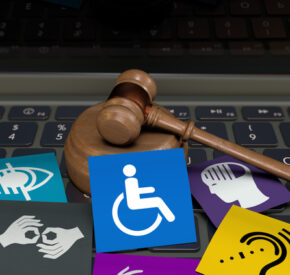Let’s Get Comfortable With Our Discomfort: Hiring People with Disabilities
Identifying and challenging workplace disability biases

Tamman had just hired its very first blind intern. Marty, its Chief of Staff and Catalyst, was ready for orientation. Paperwork, spiels about procedures, tasks to assign, people to meet … But wait. How would he explain the geography of the office? What are the policies around service animals again? He wanted to be helpful, but what’s the balance between helpful and patronizing? And if he asked the intern how he should explain these things, would he actually be showing that he was not the expert? Or worse, offend her? He was supposed to be a catalyst for change, so why was he feeling uncomfortable? As Marty explained the story to me, he admitted that although this task was relatively ordinary, it did make him worry that if he did not have all of the answers, he would not adequately communicate his expertise to someone new to the working world; he also wouldn’t be able to make her feel comfortable.
Marty moved through that feeling. He asked the intern how he could best help her to navigate the office, she explained what worked for her, and they moved on to paperwork, meetings and assignments. Marty learned a little more about what worked for his new colleague, and she was able to share her expertise on disability with him and other staff members. It turned out to be a win-win situation, but it would not have happened if he had let his discomfort rule their interactions.
If you haven’t interacted extensively with people who have disabilities, you may feel frightened, embarrassed, pitying, overwhelmed, astounded, flummoxed, or any number of uncomfortable emotions you were hoping to avoid in the routine task of choosing your next developer, writer, customer service representative, specialist, teacher, CEO, leader, recruiter, or whatever position you thought you could figure out without very much emotion. Maybe someone’s application has a lot of disability activism on it. Maybe someone has walked into a job interview using a cane, has entered your office in a wheelchair, or is accompanied by an ASL interpreter. Maybe someone is peering at a piece of paper you would only glance at or exhibits social behaviors which make you uncomfortable. Gone are the days when previous generations of employers could simply say, “You can’t do this job” and have the person escorted from the office. Let’s be clear – that’s illegal! Employers can no longer morally or financially afford to ignore disability as an important component of workplace diversity. Maybe you have a few minutes to think about this or maybe you need to respond in a split second. But in any case, what do you do? First, let’s examine and debunk some of the most common biases around disability which almost every person faces at one time or another.
Unconscious Biases: Do you really know anyone who has a disability?
Who are the people with disabilities you know well? Helping one across the street once a year does not count, especially if you did not ask them first. For many people, the first person they think of is someone who is elderly, who acquired their disability late in life, and who may still be physically and emotionally adjusting to the idea that the temporariness of their able-bodied status has shown itself. This person may have retired from work. (If, by the way, the older person has not retired and is the one sitting across from you at your desk or is using Zoom for your virtual interview, then that person deserves the same respect as any other candidate: they might just be the person you hire!) But the elderly stereotype might be the image your unconscious biases encounter when you’re faced with a typically working-aged adult who has a disability. Chances are this person has either grown up with the disability or has successfully adjusted to life without sight or hearing or walking.
Fear of the Unknown: Could it happen to me?
Yes and probably then some. Have you tried talking to someone with a disability? (Yeah, it can be that simple.) Hopefully, they can do the job for which they are applying, and probably a lot more! Have you ever considered the ways in which conveniences we take for granted in the world are designed? Signs need you to see them to know what they say, announcements over loudspeakers need to be heard, some subway stations still require you to be able to walk up and down stairs. Are you starting to understand? They exclude certain populations! Life is not universally designed. However, people with disabilities have known this for as long as they were allowed to stay alive, (because life was not automatically given to them for a while). Thus they have had to adapt to and overcome these and a host of other challenges that may not have crossed your mind. In fact, people with disabilities have paved the way for innovations that have benefitted all of us. So if you truly value innovation in your company, think about how your prospective employee, who might seem to need a lot of assistance in the beginning, might be the person who comes up with a new idea to improve something you might not have thought about yet.
Qualification Questions: What if they aren’t?
Think back to the way that interview experience went and how it might have gone. Are there ways you could have improved it? Only you know the answer. But in any case, perhaps that person was not qualified for the position you were filling, or perhaps another person had a lot more education or experience with the job. That may or may not have been due to systemic barriers in education or in employment preparation.
But in any case, have you ever interviewed a white, CIS-gendered, straight, able-bodied male for a position and then ultimately decided not to hire him? Probably. Did you then worry that your next CIS-gendered, white able-bodied male candidate would not be a good fit for a different position? Probably not. Why? Because you’ve seen and spoken with a lot of them, even if you are not one. Because they have traditionally been the most visible in the public sphere. Because they are the default candidates, at least in certain lines of work. So if you receive your *gasp* second candidate with a disability, please give them the clean slate you gave to your fiftieth white, CIS-gendered, male, able-bodied candidate. This person does not represent the first one, or the third one, or the population with disabilities, just as the last one didn’t. For your intents and purposes, each candidate represents only themselves. Still, regularly taking the time to examine your application and interview process is critical to ensure as equitable a process as possible.
Knowledge Gap: I’m unfamiliar with the disability
This candidate seems like the right person for the job, but you’re worried about including them on one of your teams. How will you orient a new employee to the office if you don’t know everything about how they work best?
The trivial answer is: just ask them what they need from you. But this answer can feel deeply uncomfortable at first. If you are the manager, it can feel strange to you not to have all the answers to everything your employee will need to know to get settled, because the employee knows a lot more about their disability than you do. Even if one blind person can use a tactile graphic, another one might prefer a verbal description, while another one may need to walk around the space a few times before understanding your layout. However, the quick answer is actually the true answer. Ask your employee how you can help best, and chances are it will not be difficult, and you’ll learn something during orientation, too.
Investment Versus Expense: This Will Be Expensive
Okay, we’ve finally gotten to it: the bottom line. People worry about the additional expenses that employees who need accommodations will incur. Initially this may or may not be true. The only way you can find out what accommodations an employee needs is to ask them after you have offered them a position and they have accepted. Sometimes they may need software that helps them to have a comparable experience with your work systems. Sometimes they may need interpretive services so that your meetings are accessible and inclusive. Occasionally your building may even need alterations so that your employee who uses a wheelchair can access it. You might think that if you don’t hire employees with disabilities, you’ve put off fixing your accessibility barriers, but if you don’t think of the prospective employee, who is trying to find work just like everyone else, think of the customers or external visitors who might not be able to enter optimally, whether it’s a physical space or a virtual one, because of your lack of accessibility. If your office environment is not accessible, it may feel, in the present moment, like a huge burden to alter structures, but if you work to do it, with everyone’s input, you will be better positioned for the future.
Although the initial cost of starting with an employee with disabilities can feel daunting, employee retention may be your biggest gain. If you have truly embraced the opportunity of the work and thought input from a person with a disability, that employee may decide to stay with your company. As The Great Resignation sweeps the nation, employees are clearly showing their workplaces that they will stay where work is fair and equitable. While there are no guarantees, if you provide an accessible and inclusive workplace, employees with disabilities, with their unique experiences, life journeys and ways of interpreting the world, may stay on to help your company become the best it can be. Ensuring physical and digital accessibility does not impact only those with disabilities, but all employees. As more and more organizations embrace diversity initiatives while eight in ten people with disabilities still struggle to seek gainful, meaningful employment, it behooves you, as someone with enough power to give others a livelihood, to expand your definition of a viable applicant pool and to embrace the possibilities that people you were not anticipating can improve your organization.
Next Steps: What Lies Ahead?
Biases can take a moment to form, a split second to activate, and some significant time to undo. We all have them, and it takes hard work to confront and dismantle them. Hopefully this essay has illuminated the most pervasive of the disability biases, and by now, you may be thinking something like, “Thanks for recognizing society’s and my limitations. But what next?” In Part 2 of this two-part blog series, we’ll take a look at simple, legal ways you can undo some of the potential biases that creep up at various stages of the hiring and retention process.





